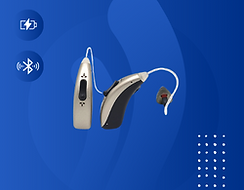Hearing Aids – Entering a New Era of Technology and Telehealth Services
- RxHearing

- May 23, 2023
- 3 min read
Updated: May 30, 2023
If you haven't looked into hearing aids in the last couple of years due to cost or appearance, or have been putting off your hearing health due to accessibility constraints, it’s time to discover what’s available in the market for you today. Just like all technology that we rely on in this world, hearing aids have progressed to be faster, smaller, more sophisticated and more affordable. In terms of services, and the onset of remote working, people are demanding a more seamless way to interact with their physicians and licensed health professionals without having to leave the comfort of their homes.

Chances are you or someone you know has hearing loss. The National Institute on Deafness states that one in three people in the US between the ages of 65 and 74 have hearing difficulties, and nearly half of those older than 75 suffer from hearing loss.
This is not just a baby boomer epidemic, hearing loss affects all age groups. A WHO report forecasted that 1.1 billion teens and young adults will permanently injure their hearing due to excessive use of headphones and attending loud social events. The good news is that nearly 95% of people with common hearing loss can be treated with a simple solution: hearing aids. Now, what technologies and features are available, and what is being developed to make them “cool” for everyone to use?
In the last 5 years, hearing aid technology has improved significantly. Standard features now include rechargeable batteries, directional microphones to reduce background noise, feedback cancellation for an easier listening experience, they’re more comfortable and discreet to wear and most are Bluetooth enabled to make self-adjustments through your smartphone.
The most advanced devices keep track of your physical health, monitor your heart rate, stream the audio from your television, and even connect with your smartphone to take calls. Modern technologies used for monitoring vital signs in wearables, like smartwatches, will soon be applied to hearing aids. Soon hearing aids will monitor one’s blood pressure, identify heart attacks and include fall detection capabilities. During these emergencies, your smartphone that is connected to the hearing aids will contact first responders with your location and share your status with them.
Before you go out and purchase a $5,000 pair of hearing aids, consider your options in the market and what features you want. Most people who have bought the most expensive, cutting-edge hearing aids end up not using most of these enhanced features. For the non-tech savvy, too many features can be unnecessary and overwhelming to use. Also, most health insurance policies and Medicare do not cover the cost of hearing aids or hearing evaluations from Audiologists.
Since the pandemic, primary care and licensed hearing specialists are utilizing telehealth as a replacement for office visits. This is mostly driven by the increased willingness and demand of their clients and patients to try telehealth. With the onset of Zoom and other virtual services to connect people “face to face”, it seems as though everyone has utilized these tools and are comfortable with using them.
This is especially true for those that live in assisted care facilities, retirement communities or are dependent on in-home care. It can be challenging for these individuals and the facilities themselves to schedule off-site appointments because of transportation barriers, skilled labor shortages or managing the potential liability that comes with safeguarding a high-risk population.

If you just want to hear better and your priorities are value, convenience and customer service. There are hearing aid companies that now provide a comprehensive suite of telehealth services and solutions directly to the consumer, saving them thousands of dollars. Some provide free professional online hearing tests and consultations with licensed hearing specialists to evaluate your hearing needs. When seeking these services, be sure to ask about their free licensed hearing care consultations, if they offer free warranties with their hearing aids, free trial periods, and loss and damage coverage.
A rapid shift to telehealth hearing care services could also be a great equalizer for a generation of people and socioeconomic status who are finding it more challenging to access affordable hearing care solutions, like hearing aids. Some 28.8 million Americans could benefit from wearing hearing aids, however, fewer than 16% wear them. And of those age 70 and older who could benefit from wearing hearing aids, fewer than 30% have ever used them. These depressing statistics can be reversed with the onset of quality telehealth hearing care services and affordable hearing aid solutions that are available in the market today.





.png)
.png)
.png)
Comments